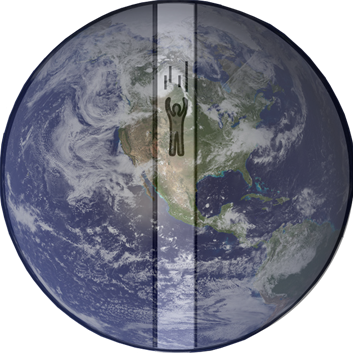THE USM SOUTHWORTH PLANETARIUM
207-780-4249 www.usm.maine.edu/planet
70 Falmouth Street Portland, Maine 04103
43.6667° N 70.2667° W
Altitude: 10 feet below sea level
Altitude: 10 feet below sea level
Founded January 1970
Julian date: 2458625.5
"A person who dares to waste one hour of time has not discovered the value of life."
-Charles Darwin
THE DAILY ASTRONOMER
Wednesday, May 22, 2019
Hole in Earth
We have been so eager to return to Pandora's jar. Predictably, it is overflowing with queries that we certainly intend to answer when time permits. (We have one about photographing between wavelengths that has proven to be a real Tiamat of a question! I thank the subscriber who asked this question for their patience.)
Today's Pandora Jar inquiry derived from what must be the richest source of scientific questions in the modern world: the underside of Snapple caps.
"Hello! My Snapple cap told me that if someone cut a hole through Earth, it would take a person 43 minutes to fall through it. But, if there is nothing under you but a hole, what is pulling on you?"
-N.F, Bridgton
Greetings!
That is an excellent question, actually. We're going to pretend that someone drilled a hole extending from the North Pole to the South Pole. We'll also ignore the pesky little details such as the extreme heat, molten core, and other factors that would prevent anyone from actually moving through this planet-wide tunnel. We'll also ignore the ocean at the North Pole as well, Santa!

Now, imagine you're standing at the hole's edge. If you jumped into it, you wouldn't float, but would, instead, plummet into the hole because all the material comprising Earth will be pulling on you. As you descend through the hole, your acceleration decreases gradually as the material above you begins to counteract the pull of the Earth matter below you. When you reach Earth's core, you've reached an "equilibrium," in which the gravitational pull along every direction is balanced. However, your momentum causes you to continue toward the South Pole. As you approach the tunnel's end, the more matter will accumulate above you than below you. You decelerate until you reach the South Pole, at which point you'll come to a brief stop before accelerating back toward the North Pole. Neglecting other tricky matters such as air resistance and the inability of any such tunnel to sustain its shape, you would then accelerate toward the North Pole again. You'd come to a stop at the North Pole before accelerating back toward the South Pole. Voila! Harmonic motion achieved.
Even though nothing is directly below you in this tunnel, Earth's material will provide sufficient pull to make you fall."